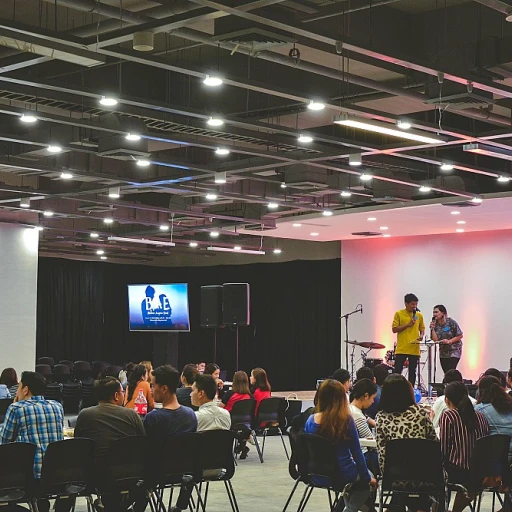Understanding Team Orientation in Modern Workplaces
Creating a Coherent Team Atmosphere
In the dynamic landscape of modern workplaces, understanding the essence of team orientation is pivotal for success. As organizations transition into intelligent work environments, the role that team orientation plays in fostering a collaborative work atmosphere cannot be understated. This transition is not merely about applying new technologies or fancy perks. Instead, it involves instilling a strong foundation of collaborative culture that empowers employees to thrive collectively.
A team-oriented work environment prioritizes the well-being of its team members, creating an atmosphere where open communication and mutual respect flourish. When new hires go through a well-structured
orientation process, they immediately sense the company mission and values. This sense of purpose helps in integrating them smoothly into the organizational culture and sets the tone for their journey.
Moreover, companies are investing heavily in employee orientation and onboarding programs, recognizing their profound impact on employee satisfaction and retention. These programs are designed to align new team members with the company's policies and procedures, as well as to foster a sense of belonging. Training days and team-building activities during this period are key, as they establish long-term bonds among employees and their roles within the company.
It is also essential to establish an environment where team members feel appreciated and valued for their contributions. Leaders play a crucial part in this, setting the stage for a culture of open communication and inclusion. Through such efforts, modern companies are inching closer to achieving a successful, team-oriented culture that attracts and retains top talent.
Leadership: The Linchpin in Cultivating Collaborative Teams
In any organization, leadership plays a critical role in shaping a team-oriented culture. Effective leaders act as a bridge between company policies and team members, guiding them to work collaboratively. These leaders set the tone for how teams function and how new hires are integrated into the company.
One of the primary responsibilities of leaders is to establish and reinforce company culture. This often begins during the orientation onboarding process, where leaders introduce new employees to the company's mission and values. This initial stage is pivotal in setting the groundwork for successful long-term integration and team building.
Training is another key aspect. Leaders need to ensure that their team has access to resources and programs that enhance team orientation. By implementing a comprehensive employee orientation program, they can help team members understand their role within the organization and recognize their contributions to the company's success.
Moreover, fostering open communication is essential. Leaders should promote an environment where team members feel comfortable sharing ideas and feedback. This not only enhances the work environment but also strengthens the bonds within the team, encouraging collaboration and innovation.
In practice, leadership should constantly evaluate and improve strategies to harness technology, as this can aid in streamlining the onboarding process and enhancing overall team performance.
The foundation laid by leadership in promoting a team-oriented work culture is crucial. It not only contributes to the professional success of the team but also positively impacts the organization’s overall employer branding efforts, ensuring that team members, both new and longstanding, align with company goals.
Impact of Team Orientation on Employer Branding
The Influence of Team Orientation on Company Reputation
In today's competitive job market, a strong employer brand is paramount. One often overlooked yet impactful factor is team orientation. A work environment that fosters collaboration not only enhances productivity but also elevates the company's reputation. Employees who feel part of a cohesive team are more likely to promote their organization positively, both internally and externally.
Team-oriented environments contribute significantly to the company's culture by creating a sense of belonging among employees. When onboarding new hires, companies that emphasize team integration often see an increase in productivity and employee satisfaction. An effective orientation program can set the tone for this team culture, helping new team members seamlessly blend into their roles and adapt to company policies.
Moreover, a team-oriented culture can be a magnet for top talent. Prospective hires who observe open communication and strong team dynamics are more likely to be attracted to the company. In fact, promoting these aspects is one of the creative ways companies can enhance their employer brand and stand out in the marketplace (source:
creative ways to recognize employees).
Ultimately, the long-term success of an organization heavily relies on its ability to maintain a team-oriented approach. Companies investing time in developing such a culture not only bolster their reputation but also ensure sustained growth and employee retention. Team orientation thus remains a crucial pillar in strengthening and maintaining a powerful employer brand.
Strategies for Building a Team-Oriented Culture
Implementing Effective Team Orientation Strategies
Building a team-oriented culture is pivotal for the success of any organization, and it begins with thoughtful and comprehensive strategies. This involves various facets from the initial employee onboarding process to the ongoing development of team members.
Onboarding and Training Programs
A robust orientation program is the cornerstone of fostering a team-oriented culture. New hires should be welcomed with a process that goes beyond simple introductions. During this time, clearly conveying the company's mission and values helps new employees feel connected to their work environment from day one. Orientation should include comprehensive training that highlights team dynamics, roles, and the importance of open communication.
Continuous Support and Development
Support doesn't stop after the first day. The ongoing role of leadership in team building involves implementing training programs aimed at developing skills necessary for team success. Establishing policies and procedures that emphasize teamwork and collaboration is crucial. Regular sessions or workshops can be organized to further integrate team members, reinforcing team orientation while honing their ability to work collaboratively.
Open Communication and Feedback
Creating a culture of open communication is vital. Employees should feel that they are part of the decision-making process and that their opinions are valued. Encouraging feedback and fostering an environment where ideas can be freely discussed helps strengthen team bonds and promotes trust.
When these strategies are embedded in the company culture, the likelihood of achieving long-term success in team orientation increases substantially, and it supports the organization's aspirations in employer branding.
Challenges in Maintaining Team Orientation
Overcoming Obstacles in Sustaining Team Orientation
Maintaining a team-oriented work environment is not without its challenges. As companies strive to foster a collaborative team culture, several obstacles may arise, requiring thoughtful strategies and dedicated efforts from leadership and employees alike.
One of the primary challenges is ensuring that new hires seamlessly integrate into the company's existing team culture. The onboarding process plays a crucial role in this regard. A robust orientation program can help new employees feel aligned with the work environment and understand their role in the team. However, a lack of structured hire orientation can lead to discrepancies in employee orientation and, ultimately, affect team coherence.
Furthermore, varying team dynamics pose a challenge, especially when expanding or diversifying the team. It's essential to have policies and procedures that support open communication and team building among team members. This includes implementing an orientation onboarding process that emphasizes the company mission and the importance of a collaborative culture.
Leadership also has a formidable role in addressing these challenges. A team-oriented approach requires leaders to be attentive to their team members' needs and encourage participation from all employees. Leading by example, showcasing best practices, and reinforcing the company culture are critical to overcoming obstacles that hinder team orientation.
Finally, the demands of time and resources cannot be ignored. To ensure long-term success, organizations must invest in continual training and development programs that hone team members' skills and foster a sense of belonging. By doing so, companies not only reinforce their commitment to a team-oriented approach but also lay the groundwork for sustained organizational success.
Future Trends in Team Orientation and Employer Branding
Shifting Dynamics in Team Orientation and Employer Branding
The landscape of team orientation is rapidly evolving, and with it, the strategies businesses employ to bolster their employer branding. Keeping up with these trends is crucial for companies aiming to remain competitive and attractive to potential hires.
The future of team-oriented environments is increasingly leaning towards enhanced flexibility and adaptability. Organizations are recognizing the importance of fostering a culture that not only values team orientation but also adapts to the changing needs of its employees. This involves integrating flexible work arrangements that accommodate diverse working styles and personal commitments. By doing so, companies can help employees feel more valued and supported.
Furthermore, technology continues to play a pivotal role in shaping team orientation strategies. Enhanced digital platforms for communication and collaboration are becoming standard in supporting virtual teams and remote work setups. Effective onboarding and training programs are now more reliant on digital tools to ensure that new hires are seamlessly integrated into the company's culture and team dynamics from day one, making the orientation process more efficient and engaging.
Organizations are also paying closer attention to the development of soft skills and emotional intelligence within their teams. Effective communication, empathy, and open dialogue among team members are seen as fundamental to building a cohesive and resilient work environment. Companies are investing in team building and development programs that emphasize these core competencies, fostering an atmosphere of open communication and collaboration.
Finally, as companies strive to maintain a team-oriented culture, they must also focus on creating transparent policies and procedures that align with their mission and values. Clear expectations and consistent practices not only help in managing team members effectively but also contribute to a stronger company culture, ultimately enhancing the organization’s employer brand in the long term.














